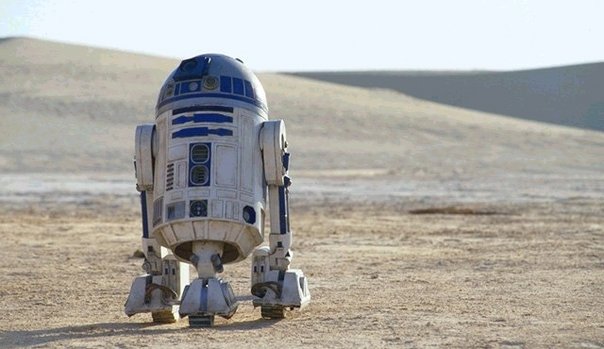 |
| R2-D2 (Image: Flickr User - WCM 1111) |
James Mugg
A recurring objection to the use of unmanned combat air systems (UCAS) for any role currently filled by fighter or attack aircraft is that robots can’t replace human fighter pilots. It’s probably a bit optimistic to say that humans will always be more capable pilots than computers, but robots don’t have to replace pilots to be useful. A fun way to stimulate thinking about unmanned systems is to look at how robots (aka droids) are used in the Star Wars movies.
Starting with the Original Trilogy (as one should), droids are mostly seen in non-combat roles. R2-D2 is essentially Luke Skywalker’s co-pilot, and his best real-world analogue is the growing computerisation of military systems. The original Star Wars movie was released in 1977, a year before the USAF introduced the F-16. The F-16’s successor, the F-35, doesn’t exactly have an R2-D2 sitting behind the pilot, but its sophisticated sensor systems and data fusion capabilities aren’t that different to having a robot co-pilot.
In The Empire Strikes Back, probe droids are used for ISR ops on a galactic scale, leading the Empire to the Rebels on Hoth. Most modern unmanned air systems are primarily ISR platforms, like the RQ-7 Shadow the Australian Army operates. ISR drones are cheap to operate and take boring tasks away from humans—the more automated the better.
The Prequel Trilogy really embraced the concept of weaponised robots. The secessionist Confederacy was able to prosecute a war against the Republic using a military comprised almost entirely of droids. In this war among the stars, as in real wars, numbers matter. Unless you’re a Jedi, your odds of survival in combat probably diminish as the number of enemies increases. The ethos of the Confederacy military was therefore to manufacture as many killer robots as possible.
Unmanned systems offer other advantages—like endurance. The Republic military relied mostly on cloned human soldiers and pilots, and the logistics of a human military are complicated. They need food and rest, and they need medical attention when injured (although being clones probably makes it easy to find organ donors). The decision to make the B-21 long-range strike bomber ‘optionally manned’ reflects the benefits of autonomy and remote piloting for long-endurance missions.
The clones and the Republic’s platforms were arguably more capable than their robotic counterparts, but the sheer number of enemies resulted in a years-long war. Similar dynamics can be seen in Western militaries since the start of the Cold War. There’s been a trend toward reduced numbers of more capable (and more expensive) platforms to ‘offset’ the adversary’s superior numbers. Just after the Korean War (PDF) the USAF inventory included more than 10,000 fighter and attack aircraft. Today, the total USAF inventory is roughly 5,000 operational aircraft, including about 1,400 fighter jets. Of course, the Empire continued that trend to its logical conclusion: the Death Star.
The RAAF currently has fewer than 100 Hornet and Super Hornet fighter jets, and it plans to replace the 71 Hornets with 72 F-35s, each of which is likely to cost about US$90m. A UCAS like the X-47B, nEUROn or Taranis could be less than half that cost, although no production-type currently exists to make any qualified estimates.
The USAF also has a deficit of 500 trained fighter pilots, which could become a shortage of 700 pilots in the next year alone. UCAS can fill that gap, transforming squadrons into a mix of manned and unmanned aircraft. Imagine if the Rebels’ assault on the first Death Star has included dozens of droid fighters to keep the enemy busy—they mightn’t have lost 90% of their pilots.
The F-35 is already being discussed as a possible command and control platform for multiple UCAS, and this has the added benefit of shoring up numbers. That style of UCAS is borne of the ‘loyal wingman’ model, but the relationship is more likely to resemble that between a military working dog and its handler than that of a wingman. Rather than being a replacement for fighter pilots, UCAS can further expand the capabilities of each pilot.
The concept of large, production-type UCAS is still hampered by the existing paradigm of fewer, more expensive aircraft. An interesting new development is the USAF’s effort to develop a cheap target drone-style UCAS. A contract for a ‘low-cost attritable unmanned aerial system demonstration’ (LCASD) was recently granted to Kratos Defense, a target drone manufacturer. The demonstrator is expected to operate at high-subsonic speeds, with a 2,800km range and 225kg of payload capacity. Best of all, the targeted unit cost is just US$2–3m—now we’re in Confederate Space.
The possibilities of UCAS are far more diverse than a simple choice between human pilots and droid pilots. That’s a false dichotomy, and it does no service to the capabilities of our air forces. It’s time to stop building Death Stars and start making droids.
James Mugg is a researcher at ASPI.
This article first appeared on the ASPI "The Strategist" Blog and is reposted here under a Creative Commons license.
